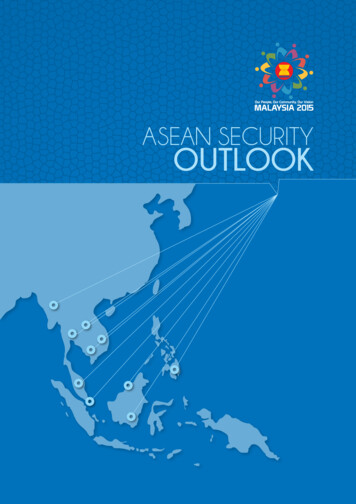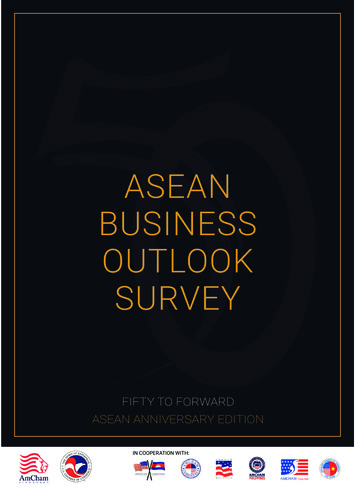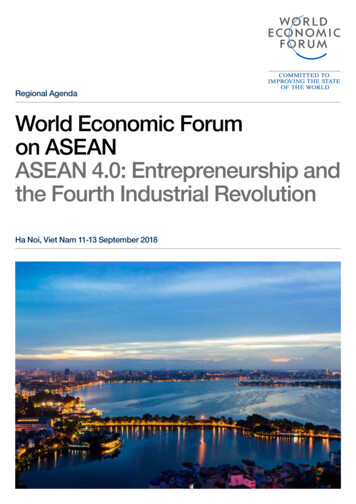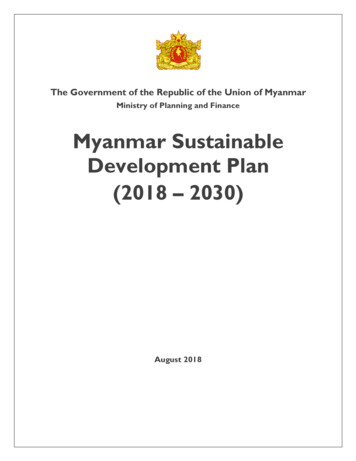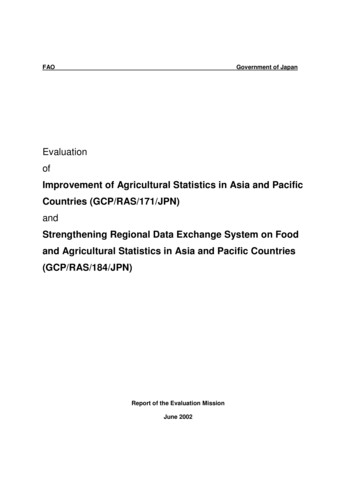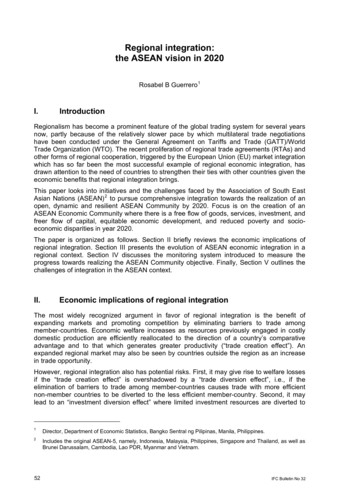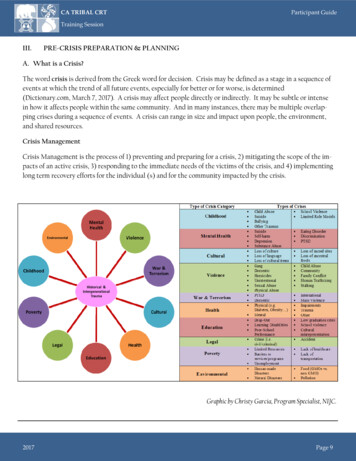
Transcription
ASEAN’S RAKHINE CRISISAssessing the regional response to atrocitiesin Myanmar’s Rakhine State
APHR is a regional network of current and former parliamentarians who use their unique positionsto advance human rights and democracy in Southeast Asia. We seek to help create a regionwhere people can express themselves without fear, live free from all forms of discriminationand violence, and where development takes place with human rights at the forefront.Our members use their mandate to advocate for human rights inside and outside of parliaments,regionally and globally. They work closely with civil society, conduct fact-finding missions, andpublish recommendations and opinions on the important issues affecting the region.APHR was born out of the recognition that human rights issues in Southeast Asia areinterconnected, and from the desire of progressive legislators to work together across bordersto promote and protect human rights.First published in 2020 by ASEAN Parliamentarians for Human Rights (APHR) APHR2020All rights reserved, this publication is copyright but may be reproduced by any method without fee for advocacy,campaigning, teaching purposes but not for resale.Cover page: Myanmar’s State Counselor Aung San Suu Kyi at the 35th ASEAN Summit in Bangkok. EPA-EFE.2ASEAN Parliamentarians for Human Rights Oct 2020
TABLE OF CONTENTSAbout APHR3List of Acronyms4Asean Bodies5Timeline of Key Events6Executive SummaryMethodology8121. Background1.1 The Establishment of Asean and the “Asean Way”1.2 Asean and Myanmar1313152. The Evolution of the Crisis in Rakhine State2.1 A History of Discrimination and Violence2.2 Maritime Movements2.3 2016 “Clearance Operations”2.4 2017 Atrocities and Aftermath2.5 Rakhine State Today1717181920223. Asean’s Response: A Critical Assessment3.1 Absence of Cohesive and Strategic Leadership3.2 A Myopic Approach3.3 Need for Transparency and Engagement3.4 Institutional Weaknesses24253041444. The Way ForwardRecommendationsTo Asean and Asean Member StatesTo the Government of MyanmarTo Parliamentarians in Southeast AsiaTo National, Regional, and International Non-Governmental,Humanitarian, Development, and Civil Society OrganizationsTo Asean Partners, in Particular Japan, South Korea, Australia, New Zealand, India,Canada, The US and the EU4849515252Annex545353ASEAN Parliamentarians for Human Rights Oct 20203
LIST OF ACRONYMSAAArakan ArmyAADMERASEAN Agreement on Disaster Management and Emergency ResponseAPHRASEAN Parliamentarians for Human RightsASEANAssociation of Southeast Asian NationsAHA CentreASEAN Coordinating Centre for Humanitarian AssistanceAHASTAd-hoc Support TeamAICHRASEAN Intergovernmental Commission on Human RightsAPGAADMER Partnership GroupARSAArakan Rohingya Salvation ArmyASEAN-ERATASEAN-Emergency Response and Assessment TeamASEAN-IPRASEAN Institute for Peace and ReconciliationASGASEAN Secretary GeneralCNAComprehensive Needs AssessmentICCInternational Criminal CourtICJInternational Court of JusticeICOEIndependent Commission of EnquiryIIFFMMIndependent International Fact-Finding Mission on MyanmarIIMMInternational Investigative Mechanism for MyanmarNLDNational League for DemocracyNVCNational Verification CardOICOrganization of Islamic CooperationPNAPreliminary Needs AssessmentUEHRDUnion Enterprise for Humanitarian Assistance, Resettlement andDevelopment in Rakhine State4ASEAN Parliamentarians for Human Rights Oct 2020
ASEAN BODIESAMMASEAN Foreign Ministers MeetingThe annual AMM is responsible for political-security cooperationand external relations in ASEAN. ASEAN Foreign ministers also meetinformally on the sidelines of the UN General Assembly in New York, andunder the ASEAN Charter, meetings may be convened when necessary.AHA CentreASEAN Coordinating Centre for Humanitarian AssistanceAn inter-governmental organisation established in 2011 to facilitatecooperation and coordination of disaster management and emergencyresponse in the region. The AHA Centre reports to the ASEAN Committeeon Disaster Management (ACDM) and the AHA Centre’s Governing Board,which consists of representatives of all ASEAN Member States.AHASTAd-hoc Support TeamA team of the ASEAN Secretariat to strengthen the role of the ASEANSecretary-General on Rakhine State, including through implementationof the recommendations of the Preliminary Needs Assessment (PNA).ASEAN leaders agreed to establish the team at the 35th ASEAN Summit inNovember 2019.AICHRASEAN Intergovernmental Commission on Human RightsA consultative body established in 2009 to promote human rights in theASEAN region. AICHR Representatives are appointed by their respectivegovernments. Although the primary body tasked with monitoring humanrights in the region, the body lacks a full protection and promotionmandate.ASEAN-ERATASEAN-Emergency Response and Assessment TeamASEAN-ERAT supports ASEAN Member States affected by disasters byconducting rapid assessments, coordinating disaster management andproviding humanitarian assistance support. The team is managed by theAHA Centre.ASEAN-IPRASEAN Institute for Peace and ReconciliationASEAN institution for research and capacity building activities supportingASEAN bodies on peace, reconciliation, conflict management and conflictresolution in the ASEAN region. The Institute was established in 2012.ASEAN Secretariat The ASEAN Secretariat provides coordination of ASEAN organs andimplementation of ASEAN projects and activities. It is based in Jakarta,Indonesia, and headed by the ASEAN Secretary-General.ASEAN SummitThe highest policy-making body of ASEAN. The biannual meeting isattended by the leaders of all ASEAN governments. The Chair of ASEAN(rotated alphabetically on an annual basis) chairs the ASEAN Summit.ASEAN Parliamentarians for Human Rights Oct 20205
TIMELINE OF KEY EVENTS6ASEAN Parliamentarians for Human Rights Oct 2020
ASEAN Parliamentarians for Human Rights Oct 20207
ASEAN Leaders at the 34th ASEAN Summit in Bangkok. EPA-EFE.EXECUTIVE SUMMARY“The purposes of ASEAN are to ensure that the peoples of ASEAN live in peace in ajust, democratic, and harmonious environment.”ASEAN Charter, Article 1(4).“ASEAN has a responsibility to protect people in the region. They have a responsibilityto protect Rohingya no matter where they are. Collectively ASEAN can be and shouldbe stronger.”Wai Wai Nu, Founder and Director of the Women’s Peace Network, Rohingya activist.1On 25 August 2017, Myanmar’s security forces launched a devastating attack on the Rohingyacommunity living in Rakhine State, in the western part of Myanmar. In the weeks that followed,thousands were killed, women and girls were raped, hundreds of homes and entire villages burnedto the ground, and more than 740,000 women, men and children forced to flee to neighboringBangladesh. The attacks took place against a background of decades-long discrimination,persecution, and violence against the Rohingya, a situation that continues today.This report examines the Association of Southeast Asian Nations’ (ASEAN) response to thiscrisis, from the initial outbreak of violence in August 2017 to the present day. It is based on 45interviews with Rohingya representatives, NGO workers, diplomats, ASEAN Parliamentarians,political analysts, and current and former ASEAN officials. It also draws on extensive review ofofficial statements and other documents, as well as NGO and media reports.1 Interview with Wai Wai Nu on 17 June 2020.8ASEAN Parliamentarians for Human Rights Oct 2020
The findings show how, caught between respect for its key principles of consensus andnon-interference on the one hand, and international and domestic outcry on the other, theregional bloc has struggled to respond to the crisis and articulate a clear vision and strategythat would help end the cycle of violence and displacement. The report examines some of thereasons behind ASEAN’s so far weak response. These include a lack of leadership both withinthe Secretariat and among Member States, giving space for the Myanmar government to setthe parameters of ASEAN’s engagement. ASEAN’s reluctance to acknowledge the underlyinghuman rights dimensions of the crisis has also meant that the bloc has focused only on the “lesscontroversial” issues, risking being at best counter-productive and at worst actively contributingto human rights abuses. ASEAN’s lack of transparency, reluctance to engage with actors otherthan the Myanmar government, and the weaknesses inherent in its own institutions havefurther undermined its response.LeadershipInitially the crisis exposed significant divisions among ASEAN Member States, which wereexacerbated by a lack of leadership at the ASEAN Secretariat, and led some States to takeindividual action. “Domestic politics so clearly trumped a regional ASEAN approach,” noted oneanalyst. Fears about the role of China, which has used the crisis to expand its influence overMyanmar, have also meant the bloc has been reluctant to take a confrontational approach, andhas placed a strong emphasis on maintaining engagement with the Myanmar authorities.This lack of cohesion and long-term vision for ASEAN in Rakhine State, coupled with itsunwavering commitment to consensus among its members, has allowed the Myanmar authoritiesto step-in, control the ASEAN narrative, and dictate what the ASEAN officials engage on, howand with whom. The result is that ASEAN’s interventions have often focused on “low-hangingfruit”, and failed to address fundamental issues. “Instead of ASEAN lifting up the region, it’s beingdragged down by its members,” said an NGO worker.However, as the crisis continued and the regional and international outcry showed no sign ofabating, ASEAN’s own credibility was increasingly being questioned, and leaders realized theyhad to take action. As a result, it embarked on a series of initiatives, which it hoped would helpaddress the situation.Understanding and addressing root causesUnfortunately, when ASEAN has been proactive, it has focused on specific issues only, inparticular the repatriation of refugees and humanitarian assistance, limiting itself to those theMyanmar government has agreed upon and leaving out politically sensitive issues such as therestoration of citizenship rights, restrictions on movement, enforced ethnic segregation, or theintensifying conflict between the Myanmar military and the Arakan Army. As one intervieweenoted, “How can you talk about repatriation when [Rakhine] is a war zone?”.In some cases, ASEAN has also appeared, at least in principle, to support some of Myanmar’spolicies of segregation and persecution against the Rohingya. For instance, ASEAN’s PreliminaryNeeds Assessment for Repatriation (PNA) in Rakhine State appears to legitimize continuingrestrictions on the movement of the Rohingya. When ASEAN delegations visited the refugeecamps in Cox’s Bazar, Bangladesh, in 2019, they promoted the National Verification Card (NVC),which is viewed by the Rohingya as a tool of their persecution. ASEAN and its Member Statesare also providing financial aid and assistance in Rakhine State for infrastructure projects, suchas schools and hospitals, seemingly without ensuring that all communities can access them.Ultimately, if ASEAN wants to have an impact and be effective in Rakhine State, it needs toproperly understand and acknowledge all aspects of the crisis, whether human rights, political,humanitarian, social, or economic. Otherwise, its attempts at intervening will be counterproductive, and risk contributing to entrenching segregation, perpetuating serious humanrights violations, and pushing more Rohingya to seek safety in neighboring countries.ASEAN Parliamentarians for Human Rights Oct 20209
Transparency and engagementASEAN’s response has also been characterized by a lack of transparency and engagementwith civil society groups, humanitarian organizations and, crucially, Rohingya themselves.The extreme sensitivity around the Rakhine crisis, in particular as a result of the Myanmargovernment’s refusal to even recognize the Rohingya as citizens, has meant that ASEAN hasbeen unwilling to provide information about its discussions and activities. Illustrative of this isthe failure of multiple ASEAN bodies and entities to respond to APHR’s requests for interviewsand information for this report.Another key weakness with ASEAN’s response has been its failure to meaningfully engagewith civil society, and in particular with Rohingya themselves. While there have been effortsto meet with the Rohingya refugees and their representatives, many felt that they were notmeaningfully consulted, and that ASEAN representatives were simply echoing Myanmar’sgovernment narratives. For many people APHR interviewed, whether Rohingya refugees, theirrepresentatives or non-governmental actors, accessing ASEAN officials also presents seriouschallenges. “We have tried, but there are not many opportunities to access [ASEAN]. Everything isclosed-door and behind the scenes,” explained one Rohingya activist.These criticisms are not new, nor are they limited to the Rakhine crisis. For years civil societyactors and others have complained about a lack of information and feedback from official ASEANmeetings and challenges in accessing and engaging with ASEAN representatives.Weak institutionsASEAN’S response has also been hampered by a lack of institutions with the mandate andexpertise to respond to a crisis like the one in Rakhine State. Its focus on humanitarian assistanceled to the mobilization of the ASEAN Coordinating Centre for Humanitarian Assistance (AHACentre), however it is primarily a humanitarian response and disaster management agency,which is ill-equipped to handle a so-called “man-made” disaster like the one in Rakhine State.The AHA Centre also lacks independence and there are serious concerns about its ability toadhere to the key humanitarian principle of “do no harm”. Despite being the main regional bodytasked with protecting and promoting human rights, the ASEAN Intergovernmental HumanRights Commission (AICHR) also lacks the mandate to respond to the crisis, and has also beenhampered by a lack of independence and the need to ensure consensus among members.Many of the institutional weaknesses in ASEAN’s response are not isolated to the situationin Rakhine State, and reflect wider institutional deficiencies, which are embedded within andintrinsic to the structure of ASEAN, and which need to be addressed for the grouping to becometruly people-centered.A way forwardWhile ASEAN’s response to the crisis has been weak and, in many respects, ineffective, it isimportant to acknowledge that the bloc has pushed internal boundaries, especially its foundingprinciple of non-interference. By maintaining strict adherence to its other key principle ofconsensus among Members States, it has kept Myanmar at the table, maintaining access withand arguably gaining influence with the country’s leaders.The question now is whether ASEAN is able to capitalize and build on this to push for real andmeaningful progress. With little change for the Rohingya in Myanmar, almost a million refugeesstranded in Bangladesh, and a new conflict threatening the safety of all communities livingin Rakhine State, there is an urgent need for a holistic, people-centered strategy. ASEAN hasan important, and potentially positive, role to play and this report therefore concludes with aseries of wide-ranging and detailed recommendations to ASEAN to ensure that its efforts donot cause further harm, but instead contribute to and promote lasting solutions.10ASEAN Parliamentarians for Human Rights Oct 2020
What has happened to the Rohingya, and continues to occur to communities in Rakhine State,is a stain on the conscience of humanity. The crisis is not an internal one, despite what theMyanmar authorities say, and its impacts are felt far beyond Myanmar’s shores. ASEAN has anobligation to serve and protect the people of the region, and has the potential to play a positiverole in resolving the situation. However, it must examine and address its own weaknesses.Failure to do so will not only harm the bloc’s credibility and legitimacy, but will likely causefurther harm and suffering to the Rohingya and others who call Rakhine State, and indeed theASEAN region, home.KEY RECOMMENDATIONS: Recognize that the crisis in Rakhine State is not simply a humanitarian one, and insteaddevelop a holistic strategy guided by the principles of “do no harm” and non-discrimination.Ensure that ASEAN’s interventions on Rakhine State address all aspects of the crisis, includingits human rights dimensions, and take effective measures to ensure that all projects aresubject to rigorous and ongoing human rights risk and mitigation assessments; Use all available political and diplomatic tools to push the Government of Myanmar to createconditions conducive to the safe, voluntary and dignified return of displaced communities,regardless of ethnic or religious identity, and request regular progress updates in thisregard. Halt any steps to facilitate the repatriation of Rohingya refugees to Myanmar, unlessand until violence in Rakhine State has ceased, and the conditions are conducive for a safereturn in dignity; and Acknowledge the Rohingya’s identity, and ensure meaningful consultation with andparticipation of Rohingya in Myanmar, the refugee camps in Bangladesh, and theirrepresentatives in all decisions concerning their future. Take effective measures to ensurethe inclusion of diverse voices, including in particular women, children, older people, andpeople with disabilities.ASEAN Parliamentarians for Human Rights Oct 202011
METHODOLOGYThis research assessed ASEAN’s response to the crisis in Rakhine State since August 2017. Itis based on extensive desk research and literature reviews. APHR reviewed reports by theUnited Nations, international, regional and local human rights and humanitarian organizations,academics, think tanks, and credible media reports, as well as reports and official statementsreleased by ASEAN and its member States.In addition, between May and July 2020, APHR also conducted 45 interviews with Rohingyarefugees and representatives, staff from regional, local and international human rights andhumanitarian organizations, current and former representatives from ASEAN bodies, the AHACentre, Myanmar analysts, former diplomats, and Members of Parliament from countries in theASEAN region. The names of interviewees are only included if consent was given. For securityreasons, some interviewee’s identities have been withheld.APHR sent official interview request letters and written questions to all Ministries of ForeignAffairs of all ASEAN countries in June 2020. We extend our appreciation to the MyanmarMinistry of Social Welfare, Relief and Resettlement for responding with written answers and atimeline, which are included in an Annex to this report. We also thank the Myanmar Ministryof Foreign Affairs for sharing their document “A Snapshot of Myanmar’s current efforts forpeace and reconciliation”.2 No responses from other governments were received by the time ofpublication. APHR regrets that the ASEAN Secretariat declined an interview.APHR wishes to sincerely thank all those who contributed their time, knowledge, and feedbackto this report, and hopes that the information and recommendations may prove to be useful forall interested parties.2 The Republic of the Union of Myanmar, Ministry of Foreign Affairs, A Snapshot of Myanmar's current efforts for peace andreconciliation, available at: orts-for-peace-and-reconciliation.12ASEAN Parliamentarians for Human Rights Oct 2020
1. BACKGROUNDRohingya refugees in Bangladesh, 9 October 2017. EPA-EFE.1.1 THE ESTABLISHMENT OF ASEANAND THE “ASEAN WAY”ASEAN was founded in 1967. Originally, it consisted of five member states: Indonesia, Malaysia,the Philippines, Singapore, and Thailand. However, it expanded in 1984 to include BruneiDarussalam, and again in the 1990s when Cambodia, Laos, Myanmar, and Vietnam were acceptedinto the fold. While the primary aim was to prevent the spread of communism and increaseregional cooperation through dialogue, the bloc has evolved considerably and today deals witheconomic, security, and humanitarian issues across the region. It became a formal legal entityin 2008, when the first ASEAN Charter came into force.3Much of the work of the regional grouping is coordinated out of the ASEAN Secretariat, which islocated in Jakarta, Indonesia. However, Chairmanship of the bloc rotates among Member Stateson an annual basis, and each Chair is responsible for holding the ASEAN Summit and othermeetings. Vietnam is the current chair, with Brunei Darussalam set to assume the role in 2021.4Areas of ASEAN’s work fall broadly in to “three-pillars”: the (1) Political-Security Community; (2)Economic Community; and (3) Socio-Cultural Community.5The supreme policy-making body is the ASEAN Summit, which is held twice annually and isattended by the Heads of State or Government of all the Member States. At these meetings,ASEAN leaders deliberate, provide policy guidance, and take decisions on “key issues pertainingto the realization of the objectives of ASEAN” as well as matters referred to it by subsidiaryASEAN bodies.63 The ASEAN Charter was adopted at the 13th ASEAN Summit in November 2007 and came in to effect in December 2008, available at: e/publications/ASEAN-Charter.pdf, [Hereinafter: The ASEANCharter].4 Chairmanship is rotated based on the alphabetical order of the English names of Member States.5 ASEAN overview, available at: https://asean.org/asean/about-asean/overview/.6 The ASEAN Charter, Article 7(2)(b).ASEAN Parliamentarians for Human Rights Oct 202013
It is also a forum in which the bloc can discuss emergency situations affecting ASEAN.7 TheASEAN Summit is also where leaders appoint the ASEAN Secretary General, a role that is heldfor a non-renewable term of five years. The current Secretary General is Dato Lim Jock Hoi ofBrunei Darussalam, who was appointed to the position in January 2018.8From its earliest days, ASEAN has been guided by the principles of sovereignty, non-interference,and consensus. These values were first articulated in the Bangkok Declaration of 1967, whichestablished the group,9 and their importance further confirmed in the ASEAN Charter, whichrecognizes “non-interference in the internal affairs of ASEAN Member States” as one of its keyideologies, along with respect for “independence, sovereignty. [and] territorial integrity”.10The principles of non-interference and consensus are embedded in all ASEAN entities andinstitutions.Often referred to as the “ASEAN Way”, this approach also places an emphasis on consensusand engagement over criticism and isolation.11 The result is that any actions or decisions takenby the bloc require all Member States to agree. In practice, this has often meant that ASEANresponses to pressing human rights issues in the region or individual Members States havebeen watered down, if indeed they are acknowledged at all.The principle of non-interference has been heavily criticized, in particular by civil society groups,who accuse ASEAN and its Member States of invoking sovereignty and non-interference as anexcuse for not engaging human rights and other sensitive issues in the region. This is not onlytrue of the crisis in Rakhine State, which is the subject of this report, but in ASEAN’s response toother crises, for example Hun Sen’s crackdown on political opposition in Cambodia, PresidentRodrigo Duterte’s so-called “war on drugs” in the Philippines, and the 2014 military coup andassociated restriction of freedoms in Thailand.The reluctance to intervene on regional human rights issues was also clearly illustrated in theASEAN Human Rights Declaration, which was adopted by the bloc in 2012.12 Many had hopedthe declaration would pave the way for ASEAN to have a stronger human rights framework,however, the final draft includes provisions that would allow Member States to restrict rightson vague and arbitrary grounds.13For some, the result is that the bloc operates on the basis of the “lowest common denominator”.Others, however, defend ASEAN’s strict adherence to the principle of non-interference, arguingthat it is essential to ensuring harmony among states and securing continued regional dialogueand cooperation.147 The ASEAN Charter, Article 7(2)(d).8 The Secretary General is selected from Member States based on alphabetical rotation.9 The ASEAN Declaration (Bangkok Declaration), Bangkok, 8 August 1967, available at: claration-bangkok-8-august-1967/.10 ASEAN Charter, “Principles”, Article 2.11 See for example, Masilamani, Logan and J. Peterson, “The "ASEAN Way": The Structural Underpinnings of Constructive Engagement. (2014); Ramcharan, R, AMCHARAN, R., ASEAN and Non-interference: A Principle Maintained, (2000) ContemporarySoutheast Asia, 22(1), 60-88; and Haacke, Jürgen, The concept of flexible engagement and the practice of enhanced interaction:Intramural challenges to the ‘ASEAN way’, (1999) The Pacific Review, 12:4, 581-611.12 ASEAN Human Rights Declaration, adopted 18 November 2012, available at: https://asean.org/asean-human-rights-declaration/. The Declaration was, and remains, deeply problematic and fails to comply with international human rights law and standards. While it recognizes that every person is born free and equal in dignity and rights (Article 1), it asserts that human rightsmust be “balanced with the performance of corresponding duties” (Article 6), and “considered in regional and national contextbearing in mind different [ ] social, cultural and religious backgrounds” (Article 7). It allows Member States to restrict humanrights on vague and arbitrary grounds, including “national security”, “public order’’ and “public morality” and bearing in mind “regional and national context[s]” (Article 8).13 National, regional, and international civil society groups have rejected the Declaration, declaring it “not worthy of its name”. SeeCivil society rejects flawed ASEAN Human Rights Declaration, Joint statement by 64 grassroots, national, regional, and international civil society groups, 15 November 2012, available at: cts-flawed-ASEAN-12429.14 Kishore Mahbubani and Jeffrey Sng, The ASEAN Miracle: A Catalyst for Peace (NUS Press, 2017).14ASEAN Parliamentarians for Human Rights Oct 2020
1.2 ASEAN AND MYANMARASEAN’s relationship with Myanmar is a complex one. When Myanmar joined the groupingin 1997, the country was widely regarded as a pariah state, owing in large part to its appallinghuman rights record.15 The then-military junta routinely arrested and imprisoned oppositionleaders, including Aung San Suu Kyi, and human rights defenders, and was waging devastatingwars against ethnic minority communities across the country. As a result, the decision to acceptMyanmar into the fold was controversial.16For ASEAN leaders at the time, the move was geopolitically strategic, which they hoped wouldcounter the influence of China, and to a lesser extent India, in the country, and thus in theregion as a whole. Some, perhaps generously, credit this policy of engagement over isolationwith having played a significant role in Myanmar’s political transition since 2011.17 For its part,Myanmar, which had become increasingly economically reliant on China, welcomed theopportunity to pull away from its neighbor’s sphere of influence; however China’s role in thecountry, politically and economically, remains significant.ASEAN’s principle of non-interference has not always been borne out in practice, particularlywhen it comes to Myanmar. During much of the 1990s, 2000s, and early 2010s, the country’sdismal human rights record was a dark spot on the group’s international reputation, especiallyas western states began to impose severe economic sanctions on the then-ruling junta in theearly 2000s.In 2005, ASEAN leaders pressured Myanmar to forfeit its role as Chair of the bloc the followingyear after the US and EU governments threatened to boycott ASEAN meetings.18 Then, in2007, as Myanmar was facing major anti-government demonstrations known as the “SaffronRevolution”, the nine other ASEAN Foreign Ministers expressed their “revulsion” over Myanmar’scrackdown on peaceful protesters and called on the authorities to “immediately desist from theuse of violence”.19ASEAN was also spurred to intervene in 2008, when Cyclone Nargis struck Myanmar’sAyeyarwady Delta, killing an estimated 140,000 people and displacing millions. Despite thewidespread devastation, the Myanmar authorities rejected international assistance, blockingaccess to the affected area. The move sparked an international outcry and pressure quicklygrew on ASEAN to step in and find a way to end the deadlock. Within a week, the bloc haddispatched an Emergency Rapid Assessment Team (ERAT) to Myanmar to assess the situationand provide recommendations for action.2015 The country had applied for observer status in 1995 and applied for membership the following year.16 The Bangkok Post, ASEAN and the SLORC Conundrum, 22 May 1997, available at: 9705/msg00432.html;17 Kishore Mahbubani and Jeffrey Sng, The ASEAN Miracle: A Catalyst for Peace (NUS Press, 2017), p. 156.18 Myanmar acquiesced, and it wasn’t until 2014 that it was able to assume the Chair of the regional grouping for the first time.19 Reuters, ASEAN voices 'revulsion' at Myanmar violence, 28 September 2007, available at: https://www.reuters.com/article/idUSN27379289.20 See ASEAN Secretariat, A Humanitarian call: The ASEAN Response to Cyclone Nargis, July 20
The Way Forward 48 Recommendations 49 To Asean and Asean Member States 51 To the Government of Myanmar 52 . camps in Cox's Bazar, Bangladesh, in 2019, they promoted the National Verification Card (NVC), which is viewed by the Rohingya as a tool of their persecution. ASEAN and its Member States
